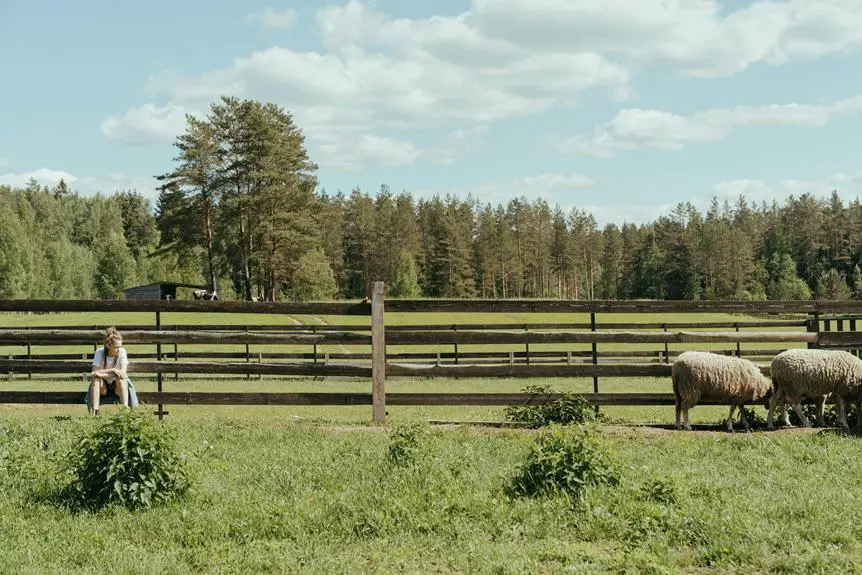When you consider fleece for your wardrobe, you might wonder about its durability and how long it'll really last. While its synthetic polyester fibers give it strength and comfort, factors like thickness, manufacturing quality, and care routines play crucial roles in its longevity. You might notice some pilling or fading after several washes, but there are ways to extend its life. So, what should you really expect from your fleece over time, and how does it stack up against other fabrics? Let's explore these questions further.
Table of Contents
Key Takeaways
- Fleece is primarily made of durable synthetic fibers like polyester, which contributes to its strength and longevity.
- Proper care, including cold washing and air drying, significantly enhances fleece durability and maintains its insulation properties.
- Thicker fleece types, such as polar fleece, offer greater wear resistance compared to thinner microfleece options.
- Frequent washing can lead to pilling and loss of insulation, so balance cleanliness with washing frequency is essential.
Understanding Fleece Composition
To understand fleece durability, you first need to know what materials make up fleece fabrics. Fleece is primarily made from synthetic fibers, with polyester being the most common. This material is lightweight, soft, and offers excellent insulation, making it popular for outdoor clothing and blankets. Sometimes, fleece may also contain a blend of other materials, like nylon or spandex, which can enhance its stretchability and comfort.
When you're looking at fleece, consider the fabric's thickness and density. Thicker fleeces typically provide better warmth and durability, while lighter versions might be more suitable for layering. You'll also encounter different fleece types, such as microfleece, which is thinner and softer, and polar fleece, known for its greater warmth and heaviness. Each type has its unique properties, impacting how well it holds up over time.
Lastly, don't forget about manufacturing processes. Fleece that's been treated for water resistance or anti-pilling will generally last longer and maintain its appearance better. Understanding these components can help you make an informed choice when selecting fleece products for your needs.
Factors Affecting Durability
Several factors play a crucial role in determining the durability of fleece, including material composition, thickness, and manufacturing processes.
When you choose fleece, pay close attention to the type of fibers used. Polyester is common and known for its strength, while blends with natural fibers might offer comfort but can compromise durability.
Thickness also matters; thicker fleece tends to withstand wear better than thinner options. If you're looking for longevity, opt for fleece that has a denser weave, as it generally resists fraying and pilling.
Manufacturing processes can significantly impact how durable your fleece is. Fleece made with high-quality techniques often comes with reinforced seams and finishes that enhance longevity. Look for brands that prioritize quality control and offer warranties, as this can be a good indicator of durability.
Lastly, consider maintenance. Proper washing and care can prolong the life of your fleece. Avoiding harsh detergents and high heat when drying can help keep the fibers intact.
Wear and Tear Resistance
Wear and tear resistance is essential when choosing fleece, as it determines how well the fabric can withstand daily use and various environmental conditions. When you're selecting fleece, look for materials that are tightly woven or knit, as these often offer greater durability. High-quality fleece typically resists pilling, tearing, and abrasion, making it a smart choice for outdoor activities and everyday wear.
You should also consider the weight of the fleece. Heavier fabrics usually provide more durability, so if you're planning on using your fleece for rugged activities, opt for a thicker option. Additionally, reinforced seams and stitching can enhance its overall strength, preventing fraying and split seams over time.
Don't overlook the importance of UV resistance as well. Some fleece materials come with built-in protection against sun damage, which can significantly extend their lifespan if you plan to wear them outdoors. By prioritizing these features, you can ensure that your fleece stands up to the test of time and usage.
Choosing the right fleece is all about finding that balance between comfort and resilience, so you can enjoy your gear for years to come.
Performance After Washing
When you wash your fleece frequently, it can affect its longevity and performance.
Using proper fabric care techniques helps maintain its quality and keeps it looking great.
Let's explore how these factors play a crucial role in your fleece's durability after washing.
Washing Frequency Impact
Frequent washing can significantly affect the performance and longevity of fleece fabrics. Each time you wash your fleece, the fibers can become worn down, leading to pilling and reduced insulation properties. If you're washing your fleece regularly, you might notice it losing its soft feel and ability to retain warmth over time.
Additionally, high temperatures and harsh detergents can exacerbate these effects, causing the fabric to break down more rapidly. You may think that washing your fleece regularly keeps it fresh, but it's essential to find a balance.
Instead of washing after every wear, consider whether the garment is truly dirty or just needs airing out.
Fabric Care Techniques
Proper fabric care techniques can significantly enhance the performance of fleece after washing, helping to maintain its softness and insulation. To keep your fleece looking great and functioning well, follow these simple steps:
- Wash with care: Use cold water and a gentle cycle to prevent the fibers from breaking down. Avoid fabric softeners, as they can coat the fibers and reduce breathability.
- Air dry when possible: Instead of using a dryer, hang your fleece to dry. If you must use a dryer, opt for a low heat setting to avoid damaging the fabric.
Comparison With Other Fabrics
Fleece stands out among fabrics for its impressive durability, especially when compared to cotton or wool. Unlike cotton, which can wear down and lose its shape after repeated washings, fleece retains its structure and softness over time.
You'll notice that fleece resists fading and pilling, while cotton often develops those annoying little balls after extensive use. When you stack fleece against wool, you'll find fleece is lighter and dries much faster. Wool can be quite durable, but it's also more prone to shrinkage and requires special care to maintain its lifespan.
Fleece, on the other hand, is typically machine washable and dryable, making it a hassle-free option for everyday wear. Additionally, fleece is often more affordable than both cotton and wool, providing you with a budget-friendly choice that doesn't skimp on durability.
If you're considering a fabric that can withstand the rigors of outdoor activities or everyday use, fleece is a prime contender. Overall, if you value longevity and ease of care, fleece clearly surpasses both cotton and wool in terms of durability.
Care Tips for Longevity
To keep your fleece looking great and lasting longer, it's essential to follow proper washing techniques.
You'll also want to store it correctly to prevent any damage.
Let's explore these care tips to ensure your fleece remains in top condition.
Proper Washing Techniques
Keeping your fleece looking fresh and lasting longer starts with using the right washing techniques. Fleece can easily lose its softness and functionality if not cared for properly. Here are some essential tips to ensure your fleece stays in top condition:
- Wash in cold water: Hot water can break down the fibers and cause pilling. Stick to cold or lukewarm water instead.
- Use a gentle detergent: Choose a mild detergent that doesn't contain bleach or fabric softeners, as these can damage the fleece material.
Storage Recommendations
Properly storing your fleece can significantly enhance its longevity and maintain its quality.
First, make sure your fleece is completely clean and dry before putting it away. Moisture can lead to mildew, so avoid folding damp items.
When it comes to storage, use breathable bags or containers. Avoid plastic bags that can trap moisture and cause your fleece to smell musty. If you're using a closet, keep your fleece on a shelf rather than hanging it, as hanging can stretch out the fabric over time.
Store fleece away from direct sunlight, which can fade colors and weaken fibers. A cool, dry place is ideal—think of a closet or a dedicated storage bin. If you live in a humid environment, consider adding silica gel packets to absorb excess moisture.
Lastly, keep your fleece away from pests. Moths and other insects can damage the fabric, so using cedar blocks or lavender sachets can help deter them naturally.
Real User Experiences
Many users have shared their thoughts on how well fleece holds up over time, highlighting both its strengths and weaknesses. You'll find that many appreciate the softness and warmth fleece provides, but there are some concerns regarding its durability.
Here are some common experiences users have reported:
- Pilling: Over time, some fleece garments develop pills, especially after multiple washes. This can detract from the overall appearance.
- Color Fading: Users often mention that vibrant colors can fade with repeated exposure to sunlight or washing, making the garment look worn out quicker than expected.
Despite these issues, many still love their fleece items for their comfort and warmth.
Users often suggest proper care methods, like washing in cold water and air drying, to prolong the life of their fleece. By following these tips, you can enhance the durability of your fleece and continue to enjoy its benefits for years to come.
Frequently Asked Questions
Can Fleece Be Recycled or Repurposed After Its Lifespan?
Yes, you can recycle or repurpose fleece after its lifespan. Many programs accept fleece for recycling, while you can transform it into pet beds, blankets, or craft projects, giving it a new life and reducing waste.
How Does Fleece Perform in Extreme Weather Conditions?
Fleece excels in extreme weather, providing warmth and insulation even when wet. It traps body heat effectively, keeping you cozy. Just remember, it's not windproof, so layer it with a wind-resistant outer shell for best results.
Is Fleece Suitable for Outdoor Activities Like Hiking or Camping?
Yes, fleece is great for outdoor activities like hiking or camping. It keeps you warm, dries quickly, and offers breathability. Just make sure you layer properly to maximize comfort during your adventures in varying weather conditions.
Are There Eco-Friendly Fleece Options Available on the Market?
Yes, you'll find eco-friendly fleece options on the market. Brands are increasingly using recycled materials and sustainable practices, so you can enjoy warmth and comfort while supporting environmentally responsible choices in your outdoor gear.
Does Fleece Retain Odor After Prolonged Use?
Fleece can retain odors after prolonged use, especially if it's not cleaned properly. To minimize this issue, you should wash it regularly and avoid fabric softeners, which can trap smells in the fibers.
- Boston Whaler Kevlar Fabric: Why It’s Used for Boat Chines - June 21, 2025
- Boron Carbide Fabric Vs Kevlar: Comparing Advanced Materials - June 21, 2025
- Best Kevlar Fabric Shears: Tools for Safe and Precise Cutting - June 21, 2025





